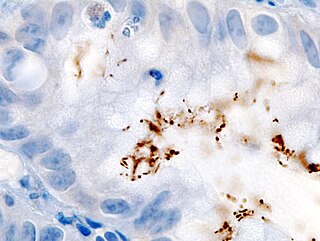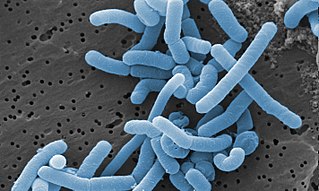
Helicobacter pylori, previously known as Campylobacter pylori, is a gram-negative, microaerophilic, spiral (helical) bacterium usually found in the stomach. Its helical shape is thought to have evolved in order to penetrate the mucoid lining of the stomach and thereby establish infection. The bacterium was first identified in 1982 by the Australian doctors Barry Marshall and Robin Warren. H. pylori has been associated with cancer of the mucosa-associated lymphoid tissue in the stomach, esophagus, colon, rectum, or tissues around the eye, and of lymphoid tissue in the stomach.
Chlamydia muridarum is an intracellular bacterial species that at one time belonged to Chlamydia trachomatis. However, C. trachomatis naturally only infects humans and C. muridarum naturally infects only members of the family Muridae.
Limosilactobacillus reuteri is a lactic acid bacterium found in a variety of natural environments, including the gastrointestinal tract of humans and other animals. It does not appear to be pathogenic and may have health effects.

Burkholderia thailandensis is a nonfermenting motile, Gram-negative bacillus that occurs naturally in soil. It is closely related to Burkholderia pseudomallei, but unlike B. pseudomallei, it only rarely causes disease in humans or animals. The lethal inoculum is approximately 1000 times higher than for B. pseudomallei. It is usually distinguished from B. pseudomallei by its ability to assimilate arabinose. Other differences between these species include lipopolysaccharide composition, colony morphology, and differences in metabolism.
Tannerella forsythia is an anaerobic, Gram-negative bacterial species of the Bacteroidota phylum. It has been implicated in periodontal diseases and is a member of the red complex of periodontal pathogens. T. forsythia was previously named Bacteroides forsythus and Tannerella forsythensis.

Helicobacter cinaedi is a bacterium in the family Helicobacteraceae, Campylobacterales order, Helicobacteraceae family, Helicobacter genus. It was formerly known as Campylobacter cinaedi until molecular analysis published in 1991 led to a major revision of the genus Campylobacter. H. cinaedi is a curved, spiral, or fusiform rod with flagellum at both of its ends which it uses to dart around. The bacterium is a pathogen.
Helicobacter canis is a bacterium in the Helicobacteraceae family, Campylobacterales order. Its type strain is NCTC 12739T. It colonises the lower bowel, but is also present in cases of hepatitis. Besides infecting dogs, this bacterium is known to cause infections in immunocompromised humans.
Helicobacter hepaticus is a bacterium in the Helicobacteraceae family, Campylobacterales order.

Helicobacter bilis is a bacterium in the Helicobacteraceae family, Campylobacterales order. It is a fusiform bacterium with three to 14 multiple bipolar sheathed flagella and periplasmic fibers wrapped around the cell. It is resistant to cephalothin and nalidixic acid, but sensitive to metronidazole. Like Helicobacter hepaticus, it colonizes the bile, liver, and intestine of mice, and is associated with multifocal chronic hepatitis and hepatocellular tumors.
Helicobacter rodentium is a bacterium in the Helicobacteraceae family, Campylobacterales order. It is a spiral-shaped bacterium with a bipolar, single, nonsheathed flagellum. It is resistant to cephalothin and nalidixic acid. Its type strain is MIT 95-1707. Its name refers to the species first being isolated from mice.
Helicobacter muridarum is a bacterium in the Helicobacteraceae family, Campylobacterales order. It is microaerophilic and helical and was first isolated from the intestinal mucosa of rodents, hence its name. It is characterised by the presence of 9 to 11 periplasmic fibers which appear as concentric helical ridges on the surface of each cell. The cells are motile and have bipolar tufts of 10 to 14 sheathed flagella. These bacteria are nutritionally fastidious and physiologically similar to other Helicobacter species and Wolinella succinogenes, but can be differentiated from these organisms by their unique cellular ultrastructure. ST1T is its type strain.

Lacticaseibacillus paracasei is a gram-positive, homofermentative species of lactic acid bacteria that are commonly used in dairy product fermentation and as probiotic cultures. Lc. paracasei is a bacterium that operates by commensalism. It is commonly found in many human habitats such as human intestinal tracts and mouths as well as sewages, silages, and previously mentioned dairy products. The name includes morphology, a rod-shaped bacterium with a width of 2.0 to 4.0μm and length of 0.8 to 1.0μm.
Helicobacter felis is a bacterial species in the Helicobacteraceae family, Campylobacterales order, Helicobacter genus. This bacterium is Gram-negative, microaerophilic, urease-positive, and spiral-shaped. Its type strain is CS1T. It can be pathogenic.
Helicobacter acinonychis is a bacterium in the Helicobacteraceae family, Campylobacterales order. It was first isolated from cheetahs with gastritis, so has been associated with this disease in this particular species and others of its kind. It is Gram-negative, spiral-shaped, and grows under microaerophilic conditions. The type strain is 90-119.
Helicobacter canadensis is a bacterium in the Helicobacteraceae family, Campylobacterales order, first isolated from humans with diarrhea. Its genome has been sequenced.
The altered Schaedler flora (ASF) is a community of eight bacterial species: two lactobacilli, one Bacteroides, one spiral bacterium of the Flexistipes genus, and four extremely oxygen sensitive (EOS) fusiform-shaped species. The bacteria are selected for their dominance and persistence in the normal microflora of mice, and for their ability to be isolated and grown in laboratory settings. Germ-free animals, mainly mice, are colonized with ASF for the purpose of studying the gastrointestinal (GI) tract. Intestinal mutualistic bacteria play an important role in affecting gene expression of the GI tract, immune responses, nutrient absorption, and pathogen resistance. The standardized microbial cocktail enabled the controlled study of microbe and host interactions, role of microbes, pathogen effects, and intestinal immunity and disease association, such as cancer, inflammatory bowel disease, diabetes, and other inflammatory or autoimmune diseases. Also, compared to germfree animals, ASF mice have fully developed immune system, resistance to opportunistic pathogens, and normal GI function and health, and are a great representation of normal mice.
Helicobacter pametensis is a bacterium in the Helicobacteraceae family, Campylobacterales order. It was first isolated from bird and swine faeces. Its cells are motile and possess one subterminal sheathed flagellum at each end.
Helicobacter anseris is a bacterium in the Helicobacteraceae family, Campylobacterales order. It is Gram-negative, microaerophilic, spiral to curve-shaped, being first isolated from the faeces of geese.
Helicobacter brantae is a bacterium in the Helicobacteraceae family, Campylobacterales order. It is Gram-negative, microaerophilic, spiral to curve-shaped, being first isolated from the faeces of geese.
Rubrobacter xylanophilus is a thermophilic species of bacteria. It is slightly halotolerant, short rod- and coccus-shaped and gram-positive, with type strain PRD-1T. It is the only true radiation resistant thermophile. It can degrade xylan and hemicellulose. The first strain of the genus Rubrobacter was isolated from gamma-irradiated hot spring water samples by Yoshinaka. This organism was found to be extremely gamma-radiation resistant, with a higher shoulder dose than the canonical radiation resistant species of the genus Deinococcus. The organism stained Gram-positive and was slightly thermophilic with an optimum growth temperature of about 60 °C.



